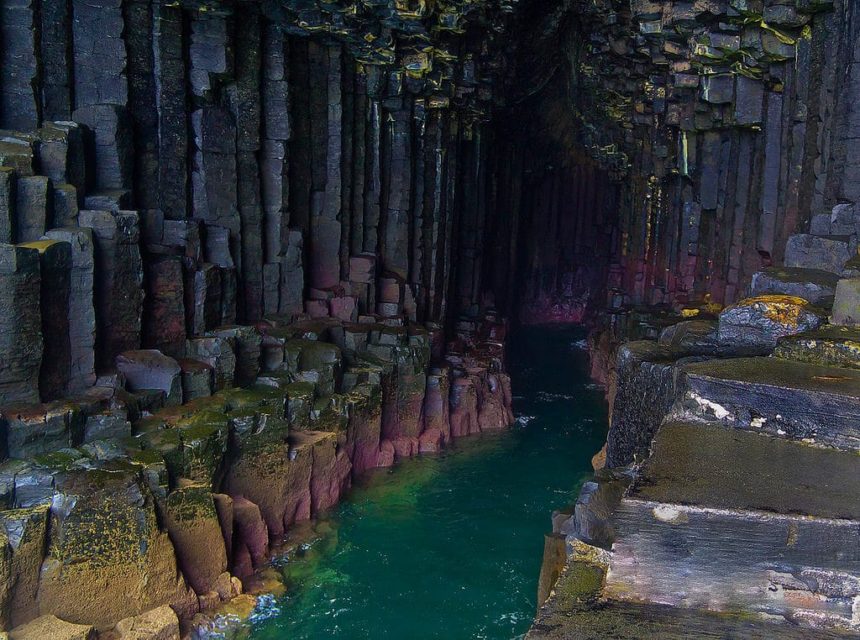Otherworldly and exceptionally symmetrical, Fingal’s Cave is one of the best known of all the caves in Scotland, and one of the best examples of volcanic basalt columns in the world. Situated on Staffa, an uninhabited island of the Inner Hebrides, Fingal’s Cave is the kind of place that looks like something out of a dream.
At 72 feet tall and 270 feet deep, what makes this sea cave so visually astoundingly is the hexagonal columns of basalt, shaped in neat six-sided pillars that make up its interior walls. These fractured columns form a crude walkway just above the water level so that visitors to go far inside and explore the cave. Because of cave’s size and its proximity to the ocean, every sound leads to an echo similar to those created in cathedrals. This phenomenon only amplifies the beauty and the mystery of Fingal’s Cave.
This visually astounding geometric sea cave looks like a contemporary masterpiece displayed in the Museum of Modern Art. Its view from the outside looks astonishing, almost daring passersby to pull ashore to explore. Inside, the natural beauty of its almost perfectly hexagonal basalt columns is matched only by the history that surrounds it — or waits inside.

Origin of Fingal’s Cave
Many who witness the columns in person insist that they must be man-made. On the contrary, they are merely a gift from nature. Exactly like the strikingly similar Giant’s Causeway at the northeast tip of Ireland, Fingal’s Cave was formed by a lava flow 60 million years ago, when molten rock burst through the chalk bed and formed the striking look of smooth, jutting pieces of stone that almost beg for a mythical explanation. That’s right — Giant’s Causeway and Fingal’s Cave look alike because they were formed by the same lava flow. At one point long ago, there may have even been a bridge connecting the two.

Myth & Legends
Like all good stories, the name behind ‘Fingal’s Cave’ is linked with ancient Scottish and Irish lore. They had a myth stating that the giant Fionn mac Cumhaill, a.k.a. Finn McCool, built a bridge from Giant’s Causeway to Fingal’s Cave in order to fight his giant rival, Benandonner. But the folklore of two giants jumping into battle was only the jumping off point to the story of Fingal’s Cave, which has since been the source of real-life legends.
Rediscovery & Popularity
In 1772, the cave was rediscovered by the naturalist Sir Joseph Banks in the same period of popularity as the poetic series “Fingal, an Ancient Epic Poem in Six Books” by James Macpherson, translated from old Gaelic. These poems highly influenced Banks, and even Goethe and Napoleon. Reportedly, inspired by the Irish legend, Banks decided to name the cave as Fingal’s Cave. Upon its discovery, a number of artists found themselves completely captivated by its magnificence.
Consequently, it is no wonder that the popularity of this natural sightseeing objective has gradually increased over the centuries. William Wordsworth, John Keats, Lord Tennyson, and Queen Victoria all visited the cave as did consummate traveler and lover of wonders, Jules Verne. Later on, the well-known band Pink Floyd released a song using the same name as the cave. While it is one of their earliest releases, the creation only adds to the popularity of this Scottish piece of land.

How to reach the cave
By sea you can get close to the cave entrance with small local ferries, between April and September. Boat trips from Oban, Dervaig, Tobermory, Fionnphort (all on the isle of Mull) and Iona allow visitors to view caves and the puffins that nest on the island between May and September. There is a landing place used by the tourist boats just north of Am Buachaille, but disembarkation is only possible in calm conditions. The island lacks a genuine anchorage. Once on the island on foot you can walk along the coast right on the broken columns outcropping just above sea level, so you can enter the cave and admire the vault.





